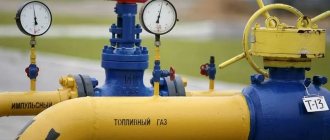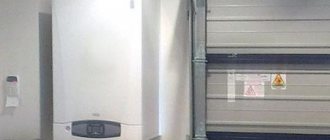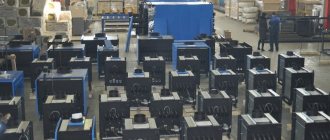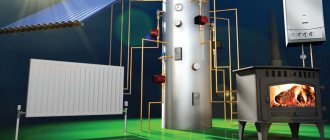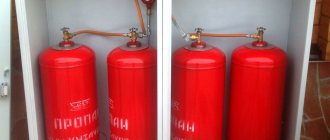Most often we think about how much fuel we have used when bills for the heat received arrive. And if the amount is frighteningly large, we begin to carry out calculations. There are methods that make it possible to calculate, for example, both at the design stage and in a completed building, the gas consumption for heating a 200 m2 house. The results obtained will help to audit the heating system and develop methods to reduce the costs of maintaining a comfortable microclimate in the house.
Having managed to calculate gas costs, heating bills will be more pleasing Source tengrinews.kz
Gas consumption by a heating boiler, calculation when purchasing equipment
When planning the purchase of a gas heating boiler, you should carefully study the efficiency of the purchased equipment for a particular house or apartment, especially in terms of gas consumption.
Boilers are produced in two main types:
- Wall-mounted ones are suitable for hot water supply and heating of apartments and residential buildings with an area of up to 200 sq.m. They are small in size, can be placed on the wall and do not take up much space in the kitchen, where they are most often installed. Wall-mounted boilers are single-circuit (for heating only) and double-circuit (for heating and water heating). The principle of heating water is flow-through.
- Floor-standing boilers are more powerful than wall-mounted ones and are designed for heating large areas (shops, production workshops, hospitals, schools, etc.). They are divided into devices with forced-air and atmospheric burners. They are located in a special room, which must meet a number of technical parameters.
In this article we are more interested in wall-mounted units
When choosing a boiler, you should pay attention to its efficiency level. For standard blue fuel boilers, the efficiency is 92-93%, for condensing boilers - 108-109%
The hydrocarbon consumption criteria are:
- type and power of equipment, burner operating mode,
- room area,
- level of insulation of external walls,
- the presence and number of doorways and windows,
- gas quality (caloric content level).
Heating wall devices are divided into devices:
- With an open combustion chamber, which uses natural draft chimneys to exhaust exhaust gases. They are more often used in private homes or on the upper floors of high-rise buildings, where there is good traction.
- With a closed combustion chamber with a coaxial chimney. They are equipped with a special smoke removal system and do not use air from the room to support the combustion process. Mainly used for apartment-by-apartment individual heating.
Nuances and subtleties
It is important to understand what the liquefied gas consumption will be for heating a house of 150-200 m2 in order to take care of how the fuel is stored. You can hold it:
- in cylinders. Their volume is small - from 10 to 50 liters. Regular replacement or refilling is required, which is not very convenient. In fact, approximately 35 liters will be needed per day for heating with liquefied gas;
- gas holders. This is a special storage (reservoir) for blue fuel. Can hold from 200 to 1000 liters depending on the dimensions. Such a structure must be built in accordance with safety requirements and standards. To refill the gas tank, you will need to call specialists. Attempts on your own may result in fires and explosions.
A gas holder - a container for storing liquefied gas for heating - can hold up to 1000 liters of “blue fuel”
As for the prices for such heating, they depend on the region where you live.
The cost of a liter of liquefied gas varies from 12 to 20 rubles. Based on the average value of 15 rubles, during the heating season you will spend approximately 121 thousand rubles on a building with an area of 200 square meters.
Any other type of fuel will be cheaper. For natural blue fuel - approximately 40 thousand rubles, for firewood and coal - about 60 thousand rubles per heating season.
What affects consumption?
A gas boiler is a complex device. The process of its operation and fuel consumption depend on various factors. One of the most important is the power of the boiler. The volume and area of the structure that needs to be heated is also important. At the same time, it is worth taking into account the features of the building, the material from which it is built, the quality of the insulation, etc., which affects the degree of heat loss, as this leads to an increase in heating costs.
Gas consumption during boiler operation is an important indicator. As practice shows, expensive units have this indicator lower. Therefore, it is better to install them. During operation they will pay for themselves quite quickly. This will allow you to save money on gas bills. Unlike such equipment, cheap equipment cannot boast of this. Therefore, whether it makes sense to purchase them is up to you to decide.
Ways to reduce consumption
The main reason for significant heat losses, which lead to ineffective consumption of the thermal energy released by the boiler unit, is insufficient insulation of the structural elements of the house. Up to 40% of heat is wasted through “cold bridges.”
Up to 35% of the heat generated by the boiler leaks through windows with poor-quality frames, up to 25% through the walls of the house, and up to 15% through the roof and entrance doors.
In order not to waste money every time heating the street, it is better to spend money once on high-quality insulation of the building. Believe me, the costs for it will be fully recouped in 3-4 years.
Thermal insulation of a house includes:
- Insulation of walls. The easiest to implement and affordable option is the installation of polystyrene foam panels. The thickness of the panels is chosen based on the climatic conditions of the construction region, the thickness of the walls of the building and the type of material used in their construction.
- Insulation of the roof or attic floor. For these purposes, sawdust, mineral wool or polystyrene foam tiles are used. The heat-insulating material, produced in the form of slabs, is mounted on the internal walls of the attic space or placed between the floor beams.
- Insulation of floors. Not only concrete, but also wooden structures need good thermal insulation. To form a thermal insulating layer, bulk and slab materials such as expanded clay and expanded polystyrene are used.
- Replacement of windows. The most reliable shield that prevents the penetration of cold into heated rooms will be PVC windows with high-quality double-glazed windows. They are made for a specific window. Thanks to this, they hermetically close the window opening, reliably protecting household members not only from the “leakage” of heat, but also from the penetration of street noise.
Proper thermal insulation allows you to reduce heat loss to a minimum.
In addition to high-quality insulation, to increase the efficiency of heat transfer, experts recommend using other equally effective measures
Experts include additional measures to increase the efficiency of heat transfer:
- Equipment of radiators with thermostatic devices. Thermal heads will maintain the required comfortable temperature in the rooms.
- In addition to radiators, install convectors with directed circulation function. They will create thermal curtains from heated air in the area of the openings.
- Connecting equipment that allows you to program optimal heating modes. Installing chronometric thermostats is effective if there are rooms in the house that are empty for several days, which there is no point in intensively heating.
The costs of purchasing and installing automation will more than pay off within the first heating season.
And finally, it’s worth reconsidering whether the system is too loaded. It is possible that it produces excess heat. And it is likely that without compromising the comfort of household members, the indoor temperature can be reduced by a couple of degrees.
At first glance - a trifle. But, considering the situation on the scale of at least one month, and even more so the heating season, such a decision can have a beneficial effect on the wallet.
Device Features
When choosing a device, it is necessary to take into account its cost-effectiveness and efficiency. As practice shows, the most common type of device is gas boilers, since they operate using fuel, which is available in any home. Thanks to modern progress, gas is available even in small villages. Therefore, people use it for different purposes: cooking, heating the house, heating water and more.
During its operation, a boiler of this type feeds a significant amount of fuel. This must be taken into account when installing and using it in your home. But there are many ways to help reduce them
To do this, it is important to take into account the design features, model, brand and other characteristics of the unit. Then it will be easy for you to choose the one that is the best option for your home, which will allow you to save gas costs and money on its payment.
How to pay less
Since you won’t be able to significantly win in price by installing autonomous heating, you need to turn to energy-saving technologies.
- Carry out thorough insulation of not only the walls of the building, but also the roof, floor, foundation, even the basement, if there is one.
- Replace double-glazed windows with energy-saving ones, the profile is frost-proof.
- Install a boiler with maximum efficiency and an electronic thermostat.
- Check the condition of the house's thermal insulation using a thermal imager to identify cold spots and eliminate them.
- Change the ventilation and air conditioning system. Just an open vent or a window set for ventilation takes in more heat than a window opened for 5-7 minutes and a complete change of air in the room.
- Install heated floors , especially in hallways and hallways.
- Install electronic sensors to block heating above the set temperature.
It is very effective to use the smart home system, which will reduce gas consumption by at least 25%. If you follow all the tips, your home will be warm and cozy, and your gas bills won’t be terrible.
The smart home system is easier and more comfortable to control using a remote control Source archidom.ru
Average calculator for calculating gas consumption for heating a house
Finding out gas consumption for the last season is quite simple. It is enough to take into account the monthly meter readings. When the heating season comes to an end, you should simply add up all the data.
Next, the arithmetic average is calculated. But to calculate the required amount of gas at the stage of purchasing a boiler, you will need to use a special formula. Gasification of an autonomous system of a private house, cottage or apartment involves the use of an average calculator, while determining heat loss. This is just an approximate calculation.
Methods for calculating specific:
- Depending on the total area of heated rooms. Here they rely on the climatic conditions of the region. For 1m2 you will need approximately 30-40 watts.
- Considering the total area of the building. So every square meter of a room with a room height of 3 m requires 100 W of heat. You will also need to take into account the climate of the region.
The main thing when making calculations is to take into account the required boiler power, which is capable of providing the premises with the required heat. When calculating, they are guided by the average figure for which 1 kW of energy is used per 10 m2. Although this calculation is the simplest, it cannot take into account all the features of the region and the building itself.
Calculating gas use will help not only choose the right boiler, but also reduce gas consumption costs. This will help save on heating costs. This way you can insulate your house and find ways to reduce heat loss.
Consumption of liquefied propane-butane mixture
Not all owners of country houses have the opportunity to connect to a centralized gas pipeline. Then they get out of the situation using liquefied gas. It is stored in gas holders installed in pits, and replenished using the services of certified companies that supply fuel.
Liquefied gas used for domestic purposes is stored in sealed containers and reservoirs - propane-butane cylinders with a volume of 50 liters, or gas holders
If liquefied gas is used to heat a country house, the calculation formula is taken as the basis. The only thing you need to take into account is that the bottled gas is a G30 mixture. In addition, the fuel is in an aggregate state. Therefore, its consumption is calculated in liters or kilograms.
Formula for calculating fuel mixture consumption
A simple calculation will help you estimate the cost of a liquefied propane-butane mixture. The initial construction data is the same: a cottage with an area of 100 square meters, and the efficiency of the installed boiler is 95%.
When calculating, it should be taken into account that fifty-liter propane-butane cylinders, for safety reasons, are filled to no more than 85%, which is about 42.5 liters
When performing calculations, we focus on two significant physical characteristics of the liquefied mixture:
- The density of bottled gas is 0.524 kg/l;
- The heat released during the combustion of one kilogram of such a mixture is equal to 45.2 MJ/kg.
To facilitate calculations, the values of heat released, measured in kilograms, are converted into another unit of measurement - liters: 45.2 x 0.524 = 23.68 MJ/l.
After which joules are converted to kilowatts: 23.68/3.6 = 6.58 kW/l. To obtain correct calculations, the same 50% of the recommended power of the unit is taken as a basis, which is 5 kW.
The obtained values are substituted into the formula: V = 5/(6.58 x 0.95). It turns out that the consumption of the G 30 fuel mixture is 0.8 l/h.
An example of calculating liquefied gas consumption
Knowing that on average 0.8 liters of fuel are consumed per one hour of operation of a boiler generator, it will not be difficult to calculate that one standard cylinder with a 42-liter refill will be enough for approximately 52 hours. This is a little more than two days.
For the entire heating period, the consumption of the combustible mixture will be:
- For a day 0.8 x 24 = 19.2 liters;
- For a month 19.2 x 30 = 576 liters;
- For a heating season lasting 7 months, 576 x 7 = 4032 liters.
To heat a cottage with an area of 100 square meters you will need: 576/42.5 = 13 or 14 cylinders. For the entire seven-month heating season, you will need 4032/42.5 = from 95 to 100 cylinders.
To accurately calculate the number of propane-butane cylinders needed to heat a cottage for a month, you need to divide the consumed monthly volume of 576 liters by the capacity of one such cylinder
A large volume of fuel, taking into account transportation costs and the creation of conditions for its storage, will not be cheap. But still, in comparison with the same electric heating, such a solution to the issue will still be more economical, and therefore preferable.
We take out a calculator
In order to preliminarily determine the average consumption of the future system, it is necessary to calculate the planned heating area, since the power of the gas boiler is selected based on this parameter. Which in turn, as we already know, determines future consumption.
It is generally accepted that to heat 10 square meters of a room with ceilings no more than 3 meters, 1 kW of heater power is required. We further assume that 1 kW of boiler power consumes approximately 0.112 cubic meters of gas.
For example, let's take a house with an area of 100 square meters. For heating you will need a gas boiler with a capacity of at least 10 kW. It’s easy to calculate - 1.12 m3 of gas will be required per hour. If the heating system of the house is designed competently and professionally, and the house is sufficiently insulated and free of unnecessary heat loss, then in the cold winter season the gas boiler will turn on the burner for about 14 hours a day.
Based on previous calculations, we determine that the boiler will consume 14 x 1.12 = 15.68 cubic meters of natural gas per day. Therefore, per month it turns out: 15.68 x 30 approximately 470 m3.
Total
Undoubtedly, when installing an individual heating system, professional calculation of all parameters and the correct selection of an individual gas boiler in terms of power and other parameters are very important. When purchasing such a unit, count on long-term operation, and for long-term savings, choose a unit with high efficiency, albeit more expensive. This will make it possible to optimize gas consumption and, as a result, save your money.
Gas heating of a private home is convenient in all respects - both from the point of view of ease of use and from the point of view of quite acceptable energy tariffs. In any case, it has few competitors in terms of efficiency, with a well-functioning system. But not everyone can afford this for the banal reason that not all populated areas, and even more so, holiday villages, are connected to gas mains.
And yet, a solution is visible - it is possible to use imported liquefied gas for heating needs, organizing its supply to the heating boiler from cylinders or from a large underground storage facility - a gas holder
But at the same time, information on average fuel consumption is of particular importance - it is necessary not only to plan the heating budget, but also to organize the replenishment of your reserves in a timely manner
What should I do? It's okay - a calculator for liquefied gas consumption for heating will help us in this matter.
Explanations for conducting calculations will be given below in the text block.
The most energy-intensive gas equipment in a residential area is a gas boiler, which provides water heating in the heating system, and often for domestic needs. Individual gas heating is becoming increasingly attractive to consumers who do not want to depend on the problems of centralized heating.
How to calculate the need for thermal energy
The simplified formula for this calculation looks very simple - 1 kW of thermal energy is spent on heating 10 m2 of building area. A more accurate formula operates not with areas, but with the cubic capacity of the house, also taking into account the height of the ceilings in the room. But for standard-type dwellings with a ceiling height of 2.5-2.7 meters, the above simplified proportion is valid. An accurate calculation of the need for thermal energy operates not only on the volume of heated space, but also on the heat resistance of walls, openings and ceilings. In addition, in this case, the average annual temperature and other nuances are taken into account.
Boiler room
However, in order to calculate the volume of fuel, a simple formula will be enough for us: 1 kilowatt = 10 square meters. As a result, heating a building with an area of 150 or 200 square meters requires spending 15 or 20 kW, respectively. And this is only an hour. But the boiler does not consume gas every minute. The work/downtime period here is divided in the proportion of 50/50 percent. Therefore, per day, a house with an area of 150 square meters will spend 180 kW (15x24/2), and a home with an area of two hundred square meters will spend 240 kW.
The cold season in our latitudes lasts from October to April - 7 months or 210 days. Therefore, annual thermal energy consumption will be 37,800 and 50,400 kW. We will focus on these values in our further calculations.
Wall boiler
Gas boilers can not only be installed on the floor, but also mounted on the wall. If the second option is used, then the device operates using electricity. Therefore, it is necessary to take this into account when calculating the costs of its maintenance.
Electrical energy facilitates various processes in the system. This includes pump circulation, automatic system adjustment, ignition, fan, etc. Therefore, there is no way to avoid costs of this type in a wall-mounted gas boiler.
But few people know how much electricity a gas boiler consumes. It is quite logical that this question arises. Electricity consumption at different stages of its operation differs. So, in operating condition this value is 65 W, and as soon as it ignites, the electricity consumption almost doubles and amounts to 120 W.
It is also worth considering additional elements in the unit. If there is a fan, then it also requires electricity to operate. In this case, the cost of operating the device increases by 30-35 W. By summing up these values, you can get how much electricity a gas boiler consumes.
Experts' opinions
Gas consumption for heating a house of 150 m2, according to experts, depends on the efficiency of the boiler, the correctness of the installed system, and the equipment manufacturer. For the most detailed cost calculation, you should consider:
- cost of combustible materials;
- operating costs;
- cost of equipment, its delivery and installation;
- air temperature during cold periods;
- mode of residence in the house (temporary or permanent);
- degree of modernization of the building (material of construction, presence of insulation, etc.).
Example: Forumhouse user used the following as calculation data:
- house area – 150 m2;
- duration of the heating period – 6 months;
- System efficiency – 0.5;
- specific power of the climatic zone is 1.5 kW.
After calculations, the following results were obtained:
- the average volume of raw materials to produce 1 kW/h of heat is 0.1 m3;
- gas cost (approximate) – 5 rubles/m3;
- the cost of 1 kW/h of gas is 0.5 rubles;
- heating costs for the season - 11,000 rubles.
Calculation of gas boiler consumption
Boiler installation diagram.
Correctly calculating gas consumption for autonomous heating is not difficult; it does not require special skills, you just need to know the basic parameters. To do this, we need to know the power of the unit and the area of the heated room. The heating season per year can be up to 250 days. But as a rule, during this period we do not always turn on the gas boiler at full power. After all, winters can be both very cold and relatively warm, therefore, even with maximum load on the heating system, the boiler operates at full capacity for less than 100 days. If we assume that the boiler operates all day long for 30 days and multiplying these data, we get kilowatt-hours. However, as we said earlier, the boiler is not operated in this mode, so this figure can be safely divided by 2, and thus we get the average consumption per month. We multiply it by the number of months of the heating season (usually 7) and get gas consumption for the year. As for the boiler power, it is taken from the calculation of 1 kW per 10 m².
Let's look at how this works using a separate example. If the area of your premises is 100 m², then you need to choose a boiler with a capacity of at least 10 kW. To calculate gas consumption, we multiply the boiler power by 24 hours and by 30 days, it comes out to 7200, divide in half and get the monthly thermal energy consumption, which is equal to 3600 kW/hour. To calculate for the entire heating season, we multiply this figure by 7 (the number of heating months) and get the annual boiler power consumption or annual consumption in the amount of 25,200 kW/hour.
This figure won’t mean anything to most people, so consumption can be converted into a monetary equivalent. To do this, you need to know the exact cost of gas per 1 kW/hour. For example, it is 15 kopecks. We take our calculated data of 25200 kW/hour and multiply it by 0.15. Thus, we get annual heating costs in the monetary equivalent of 3780, that is, the price for heating a room with an area of 100 m².
Gas boiler chimney diagram.
To make the picture clearer, you can calculate the gas consumption for heating in m3. To generate thermal power of 1 kW, on average, a boiler consumes 0.112 m3. We have already found out that the boiler power consumption per 100 m² should be 10 kW, multiply it by 0.112 and get gas consumption per hour of 1.12 m3. The data obtained can be multiplied by 24 to obtain gas consumption per day. The formula looks like this:
- 1.12*24=26.88 (consumption per day);
- 26.88*30=806.4 (monthly expense);
- 806.4*7=5644.8 (consumption for the heating season).
Now all that remains is to multiply the resulting figure by the tariff. It seems to you that this is not so much, but ever-growing tariffs force us to look for all sorts of ways to save money, and why pay more if it is possible to reduce the consumption of “blue” fuel. And when we are talking about a country house with an area of 800 m²? Let's try to figure out how to reduce the amount of natural gas consumption for heating.
How much does heating cost?
The amount of heating depends on the amount of gas consumed and the price per 1 m3 in a given region. By simply multiplying two numbers, you can determine costs per day, per month or for the entire heating season.
In terms of absolute price per m3 (kg), main methane is 3-4 times cheaper than propane-butane mixture. However, when comparing the heating consumption of a building of 100 m2, methane requires an average of about 3000 m3, and only 1000 m3 of liquefied mixture. Therefore, it can be argued that how much liquefied gas costs for heating a house is the same price for main gas, due to higher consumption.
Main gas flow rate in gas heating boilers formula
Gas consumption in boilers directly depends on the power of the heater. The necessary power calculation is carried out when purchasing heating equipment. In this case, they rely on the size of the heated area. The calculation is carried out individually for each room, taking into account the lowest average annual temperature.
When calculating power, they use the ratio of kilowatts per 10 m2 of space that is heated. Taking into account temperature changes, only half of the value will be needed, which is only 50 W per hour. For an area of 100 m2, 5 kW is enough. Formula for calculating natural gas: A = Q / q * B.
Explanation of the formula:
- A – the required amount of gas for heating;
- Q – boiler power for heating a house (5 kW is enough for 100 m2);
- q is the minimum amount of specific heat, measured in kilowatts and depends on the type of gas;
- B – boiler efficiency, percentages should be converted.
To determine consumption, simply substitute the original data into the formula. For a house with an area of 100 m2, 0.557 cubic meters per hour is enough. For 150 m2, 0.836 will be required, and for an area of 200 m2 - .114. To find out how much a gas unit consumes per day, simply multiply the resulting number by 24. Multiplying the indicator by 30 will determine how many cubic meters are needed for heating per month.
Types of gas
Heating private houses and cottages with an area of over 150 square meters requires a large amount of fuel. For this reason, when choosing a suitable coolant, one should take into account not only the degree of its heat transfer, but also the economic benefits of its use and the profitability of equipment installation. Gas best meets the listed parameters.
For a larger room area, more fuel is needed
Types of gas:
- Natural. It combines hydrocarbons of various types with a predominant proportion of methane CH4 and impurities of non-hydrocarbon origin. When one cubic meter of this mixture is burned, more than 9 kW of energy is released. Since gas is naturally located underground in certain rock layers, special pipelines are laid for its transportation and delivery to consumers. In order for natural gas to flow into the house and heat it, it is necessary to connect to such a pipeline. All connection work is carried out exclusively by gas service specialists. Their work is valued quite highly, so tapping into a gas main can cost a large sum.
- Liquefied. Includes substances such as ethylene, propane and other flammable additives. It is usually measured not in cubic meters, but in liters. One liter, when burned, produces about 6.5 kW of heat. Its use as a coolant does not imply an expensive connection to the main pipeline. But to store liquefied fuel, it is necessary to equip a special container. As gas is consumed, its volume will have to be replenished in a timely manner. The cost of transportation must be added to the cost of a permanent purchase.
Once the choice in favor of one or another type of fuel has been made, you can determine the gas consumption for heating a house of 150 m². A special formula should be used for calculation.
You will see the principles of heating with liquefied gas cylinders in this video:
A simple calculation of the consumption of a liquefied gas boiler per month
The above calculation formula is also used for other types of fuel. This way you can calculate the amount of liquefied gas in cylinders. The calorific functions of this type of fuel have their own differences. Liquefied gas is calculated in kilograms and then converted to liters.
Gas consumption from the gas tank per month:
- For an area of 100 m2 you will need 560 liters;
- For 150 m2 – 842 l;
- For 200 m2 you need 1122 liters;
- An area of 250 m2 is heated with 1403 l.
A regular cylinder holds 42 liters. To determine the number of cylinders per year, it is enough to divide the amount of gas by the standard size of the gas tank (42). Then you should multiply the number of cylinders by the cost of one to get the cost of such heating.
(no votes yet)
Which gas to choose - which is more profitable?
To connect to the main gas pipeline, the user will have to pay for the project and installation work. And these expenses cannot be called insignificant. The growing appetites of gas services make gasification of homes a very expensive undertaking. However, all these expenses pay off during operation. As of March 2022, the cost of a cubic meter of gas, depending on the region of the Russian Federation, ranges from 4.44 to 8.66 rubles. The average price is 6.55 rubles. As a result, heating a house with natural gas of 150 or two hundred square meters, taking into account the estimated consumption rate for the season, will cost 29,825 and 39,038 rubles.
Liquefied fuel does not require insertion into the main line, but to store it it is necessary to build a gas tank - a container that accepts the required volume of fuel. In addition, this container will have to be periodically filled with gas, which is delivered to the site using special transport, and this service is not cheap. And the gas tank will have to be repaired and maintained. After all, the safety of all residents of a house heated by liquefied gas depends on its condition.
Liquefied fuel storage
At the beginning of spring 2022, a liter of liquefied gas at gas stations cost from 11 to 20 rubles, depending on the region of the Russian Federation. The average cost of this fuel was 15.5 rubles. Therefore, heating a 150-square-meter house with liquefied gas will cost 98,394 rubles. For housing with an area of two hundred square meters you will have to pay even more - 131,192 rubles. As you can see, liquefied fuel has surpassed natural gas in cost by 3.3 times. Therefore, conclusions regarding whether it is profitable or unprofitable suggest themselves - natural (main) gas, with all the bureaucracy and complexity of the connection process, will be much more profitable than liquefied fuel.
Types of gas connection - what determines the cost and quality of heating
Many consumers begin to think about how much “blue” fuel was consumed only after receiving a significant bill for the consumed heat. If the amount is significant, then the homeowner begins to figure out how to spend less gas.
There are different methods to determine what the consumption of a gas boiler will be for heating a private home. It is important to take into account one point here - gas can enter the home in different ways:
- main gas. The composition is purified from methane, but a fragrance is added to it, which makes it possible to detect a leak. The mixture is supplied through gas transportation systems to consumers;
- liquefied gas. Propane is mixed with butane and enters the gas tank. In the future, an autonomous supply of gas to the living space is ensured. Before supplying the composition, the liquid turns into a gaseous state and the pressure in the container increases. The usual red cylinders are used as an analogue of a gas holder.
Note! Each option has its own advantages. The gas tank provides complete autonomy, but it is very expensive to maintain. Main gas is cheaper, but its quality is worse.
Initial data for calculations
To perform a preliminary calculation, you need to find out the following parameters:
- calorific value (calorific value) of natural gas supplied in your area;
- thermal load on the heating system;
- Efficiency of the boiler that is planned to be installed in a house or apartment.
The calorific value of the fuel is taken based on the value of the lower calorific value of the main gas.
Theoretically, when burning 1 m³ of blue fuel, 9.2 kW of thermal energy is released. In practice, this value differs and, as a rule, to a lesser extent. Due to the same rise in price, some unscrupulous suppliers dilute gas with air, which is why its calorific value can decrease to 7.5-8 kW/m³.
To determine gas consumption for heating a house, it is better to find out the caloric value from the management company, and when this fails, use a reserve figure: 8 kW/m³. If they share with you information about the specific heat of combustion and give you a figure expressed in other units, kcal/h, then you can convert it to Watts by multiplying by a factor of 1.163.
Another important indicator that directly affects fuel consumption is the thermal load on the heating system, which consists of heat losses through the building structures and losses due to heating of ventilation air. The best option is to perform or order an accurate calculation of all heat losses, but in the absence of any other option, you can determine the load using enlarged methods:
- If the ceiling height does not exceed 3 m, then the heat consumption is assumed to be 0.1 kW per 1 m² of heated area of the building. Thus, for a house of 100 m2 you need about 10 kW of heat, 150 m2 - 15 kW and 200 m2 - 20 kW of heat energy.
- Apply 40-45 W of heat per 1 m³ of heated room volume. The load is determined by multiplying this value by the volume of all heated rooms.
The efficiency of the heat generator, which affects the efficiency of fuel combustion, is indicated in its technical data sheet. If the unit has not yet been purchased, then you can take the efficiency of gas boilers of various types from the list:
- gas convectors - 86%;
- boilers with an open combustion chamber - 88%;
- heat generators with a closed chamber - 92%;
- condensing boilers - 96%.
Meters for measuring fuel consumption
The meter measures the amount of gas at different conditions of temperature and pressure and, using special equipment, brings the result to the indicator that will be under standard conditions (SU) - +20 °C and 101 kPa.
The volume of fuel for the control system is determined by the formula Vс = V×(p×Tс/pс×T×K) , where
- V is the volume of gas;
- p—density;
- T—thermodynamic temperature;
- K is the fuel compressibility coefficient.
Values with the letter “c” are indicators for standard conditions, without - for workers.
In everyday life, membrane, rotary and ultrasonic meters are used, in large enterprises - turbine and vortex meters - these are the most popular types of gas meters. In gas industry plants, volume is determined mainly by variable pressure changes in constrictions, often between 2 flange connections in close proximity. The meters differ in their operating features.
The image shows a classic membrane meter (diaphragm, chamber), in the compartments of which there are membranes that move from the movement of gas and determine its volume
Diaphragm flowmeters provide minimal calculation errors and consume little electricity. The devices provide readings over a wide range, but with a low maximum pressure - up to 0.5 bar. In everyday life, the meter performs best, since the calibration interval reaches up to 10 years with high reliability of the device. The design does not respond well to mechanical gas contamination and is generally very bulky.
Rotary, or rotary , models do not depend on the electrical network; they are suitable for small industrial facilities, but they are less convenient. With a small installation area and high precision under conditions of sudden pressure changes, they make noise and more often fail. They are “afraid” of pneumatic shocks and pollution.
Ultrasonic meters are small in size and vary significantly in the complexity of their structure. Acoustic gas meters are valued for their reliability and ease of installation. Some devices contain non-volatile memory. Meters for standard sizes G1.6 and G2.5 are relatively expensive.
Turbine devices are used to measure the amount of household and aggressive gases and multicomponent compositions. Meters have become widespread at gas pipelines and chemical plants. Turbine devices record large quantities of gas at pressures up to 10 MPa and vary significantly in size and operating pressure. These are universal instruments for measuring natural gas flow in industry.
The turbine meter is a fragment of a pipe: in Figure 1 - housing, 2 - gas flow rectifier, 3 - measuring mechanism with a turbine, 4 - magnetic coupling for transmitting rotation to the counting mechanism, 5 - counting mechanism
Vortex meters measure the volume of natural or inert gases. In terms of measurement range they have an advantage over other models. They detect the slightest movements in the gas mixture and determine large quantities of gas per diameter. The efficiency of a vortex flow meter is directly proportional to the fuel flow rate.
Measurement methods used in gas flow meters
Fuel consumption is calculated using direct and indirect methods.
In the case of direct gas, gas fills the measuring chambers and leaves them. The volume passed correlates with the filling-emptying cycles. Counting in membrane, rotary and drum counters works according to the described principle.
Gas meters with an indirect measurement method work with speed indicators and a known cross-sectional area. The counting method can be mechanical or other, related to the characteristics of the counter. In mechanics, turbines, impellers, and balancing elements are used.
The indirect method of calculation has other methods:
- vortex detection;
- measuring the pressure difference on the constriction device;
- calculation of heat transfer from a heated body;
- measurement of velocity pressure;
- counting based on ultrasonic movement.
The correctness of indirect methods depends on the correspondence of the speed in direction and cross-section. Flow preparation means help: turbulators, condensers and flow straighteners. The devices come separately or as elements of meters.
The principle of operation of a vortex gas meter: a streamlined body has a balancing element, due to which vortices alternately pass from the right to the left - the sensor will not record anything if the gas speed drops to a value at which vortices are not formed
The devices can determine the difference in speed across the cross section simultaneously with the speed of gas movement and thus reduce the error. The latter often occurs due to fuel stagnation near the walls. Read more about direct and indirect methods for determining gas consumption below.
How is gas pressure determined?
Pressure is measured directly using pressure gauges or by adding the values of atmospheric (Pb) and excess pressure (Pi). Pb is measured at the location of the Pi converter, if the latter is in a closed space and there is pressure or vacuum in it.
Pressure gauges measure pressure and indirectly the speed of gas movement, which helps determine the amount of fuel consumed, as well as calculate the benefits of the meter
The pressure tapping hole for vertical and horizontal pipes is placed radially. On a transverse pipeline it is located in the upper half of the section.
In flow meters without the specified hole, sampling is carried out in front of the meter, at a distance of 1 to 3 pipeline diameters, with a reference point from the gas meter inlet flange.
How to calculate gas using a calculator
The amount of fuel consumed is determined according to the following rules:
- LPG consumption excluding hot water: S x Hп x Qк x K, where: S – heated area, Hп – ceiling height, Q – thermal energy losses through the enclosing structures, K – coefficient used for additional premises (storage room, attic, basement) .
- Consumption for hot water: values obtained in kW/h must be converted into units of l/h (converted through Kcal and m3).
- We recalculate the final l/h to an annual value (we multiply the consumption per hour by the operating hours of the equipment for the year).
When calculating, we take the following coefficient values (K):
- K hot water supply – 1.15;
- K (o) heated additional areas (basement + attic) - 0.95.
- K (n.o.) total (unheated (n) basement + heated (o) attic – 1.
- K (o) basement – 1.
- K (n) basement – 1.05.
- K without basement and attic floor - 1.1.
- To convert Q (thermal) values in kW to Kcal – 1.163.
- To convert m3 to l of liquefied fuel - 2.37.
- The number of operating hours of equipment annually is 2,265.
- The average equipment efficiency is 0.92.
